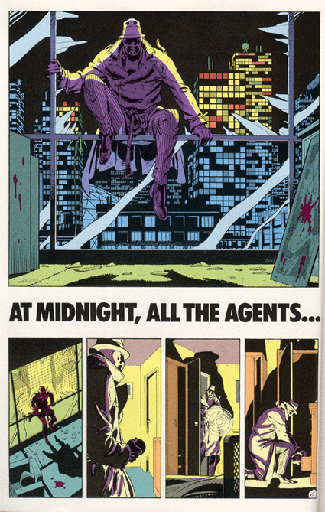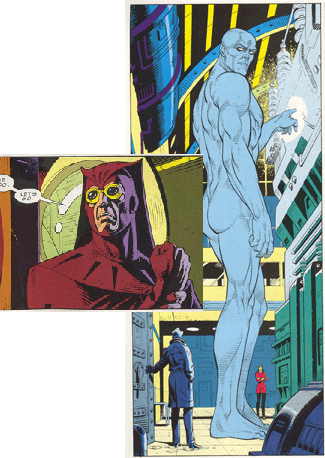

Continued from part 3, page 2...
PART FOUR
The Story And Analysis
-"This city is afraid of me. I have seen its true face"-
Rorschach
(* A warning. This essay is a full discussion about the story, symbolism,
and political commentary of the Watchmen series. Therefore, expect "spoilers"
herein. It is suggested that the series be read before this essay.)
Book One
As the story begins we read Rorschach's evening journal entries describing
his thoughts of the day. In a rambling series of short declarations he
complains about how the world has gone down hill. He praises president
Truman as a "good man," a few lines later attacks "lechers
and communists," then he hits on "liberals and intellectuals
and smooth talkers" and he affirms that "the whole world is
standing on the brink staring down into bloody hell" because of them.
After a page of Rorschach's journal right away the reader is treated to
the gritty realism the series will feature as the super-hero named The Comedian
(real name Edward Blake) in his elder years is attacked in his high rise apartment, beaten,
and bodily thrown out a window to his death. The Comedian's ever present
smiley face button goes out the window with him falling to the ground
splashed with his own blood -- a symbol that serves as the icon for the series. We see this attack as a flashback in lurid
red coloration while police detectives discuss the case later at the crime
scene.
From there we follow Rorschach as he investigates the murder of The Comedian,
an acquaintance of his and long time super-hero that worked in covert operations
for the US government.
We are led to see Rorschach as one on the brink himself, the brink of
madness. Even the word bubbles for him are choppy and broken in a ham-fisted
device to further give us the feeling that he is over the edge. In the
first book, Rorschach breaks into a crime scene, breaks into a friend's
home as an unwanted visitor destroying the poor fellow’s door, and
brutally breaks the fingers of a drunk in a bar to elicit information.
By page 14 he is complaining about welfare mothers and by page 19 he is
wondering if a fellow hero is a homosexual pushing many of the classic 80s
hot button issues.
Apparently, Rorschach is the writer's idea of a typical "right winger."
One interested in law and order at the cost of freedom of expression.
He is a man whose pent up hatreds and fears override his humanity, even
his sanity. A true Leftist's boogyman.
In short order, we are also treated to another of the Left's boogymen. On page 19
that boogyman takes the form of a sign that Rorschach walks past that touts the "Rockefeller Military
Research Center." The boogyman of the eeevil, rich Rockefeller family is employed here. Little rhetorical flourishes like that appear throughout the book.
As the story line evolves we discover that in 1977, Congress passes the
"Keene Act" outlawing super-heroes and forcing them into retirement.
At this we realize Rorschach is operating as a masked hero illegally. Soon we are introduced to
several more characters. The Nite Owl (real name Dan Dreiberg), a fattened,
frustrated, unsure, sexually impotent super-hero retiree. Ozymandias (real
name Adrian Veidt), the "smartest man in the world" and former
super-hero. Dr. Manhattan (real name, John Osterman), a blue skinned fellow
who we later find out was mutated by a lab accident into a molecular manipulating
super-being now working for the US government. And Manhattan's aging girlfriend,
the Silk Spectre (real name Laurie Juspeczyk), who plays the "humanizing"
factor for Dr. Manhattan, keeping him in touch with humanity, both his
and ours.
Click to continue to book 2...





Home|Prelude|Part
1|Part
2|Part
3|Book
1|Book
2|Book
3|Book
4|Book
5|Book
6
Book
7|Book
8|Book
9|Book
10|Book
11|Book
12|Epilogue|Footnotes